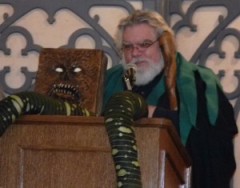As of this writing, a Wizard of Oz remake is about to hit the big screen. Has it ever occurred to you that The Dunwich Horror might be understood as rewriting of The Wizard of Oz?
Consider the parallels. The Dorothy Gale analogue (though I wouldn’t suggest getting a Judy Garland look-alike to play him) would be Dr. Henry Armitage. It is he who will set out on an enchanted journey to the Emerald City of Dunwich. He is prompted to that mission by his encounter with Wilbur Whateley who seems a veritable monster but is actually quite easily overcome, as it happens, by Dr. Armitage’s guard dog in the University Library. Let me suggest, in pompous scholarly tones, that the watchdog is Lovecraft’s version of Toto, while Wilbur Whateley (note the double “W” in the name) is the counterpart of the Wicked Witch of the East, killed as soon as we see her, felled by the falling Gale farmhouse, the carrying away of which by the tornado echoes the eventual destruction of the Whateley farmhouse by what appears to be an invisible hurricane.
The real Dunwich Horror of the title is Wilbur’s fraternal twin, and it corresponds to the Wicked Witch of the West, who of course looks exactly like Lovecraft in drag (don’t expect me to believe you’ve never noticed!). She, and the Twin, pass out of the world in similarly anticlimactic ways, one doused with simple water, the other spritzed with an atomizer. And if we need an analog to Glenda the White Witch, it must surely be albino Wiccan Lavinia Whateley.
Henry Armitage, like Dorothy, is accompanied on his trip to the fabled city by two allies, fellow faculty Rice and Morgan, and then, in effect, they pick up a third savant, the local lore-master, Zebulon Whateley. Together, these men are Lovecraft’s version of the Scarecrow, the Tin Woodsman (Rice even has a rifle to match the Woodsman’s axe), and the Cowardly Lion. The frightened but feisty Dunwich villagers are perfect Munchkins. The winding rural roads lined with domed hills and populated with eerie, unnatural-seeming trees are mirrored by the Yellow Brick Road and enchanted apple trees who pitch their fruit at passersby. The powerful, talismanic ruby slippers, so coveted by the Witch of the West, correspond to the Necronomicon. The Witch and Wilbur alike perish in pursuit of these grails.
The psychopomp whippoorwills of “The Dunwich Horror,” conveying dead souls to their terrible fate, match up with the Wicked Witch’s flying monkeys (though Lovecraft’s Night-Gaunts would be an even better match—too bad they’re not in this story!). The Great Oz himself is none other than Yog-Sothoth, looming above mere mortals in his thunder-croaking firmament. He turns out to be a mere showman cringing behind a curtain, and it is his disappointing human persona, Professor Marvel, whom we may match with Wizard Whateley. As Stan Sargent has noted, Old Whateley must have been the physical stand-in for Yog-Sothoth during the impregnation of Lavinia Whateley. Again, a disappointing old geezer is all you get when you’ve been promised a god!
Have I convinced you yet? Somehow I didn’t think so.

Robert M. Price is an American theologian and writer. He teaches philosophy and religion at the Johnnie Colemon Theological Seminary, is professor of biblical criticism at the Center for Inquiry Institute, and the author of a number of books on theology and the historicity of Jesus, including Deconstructing Jesus (2000), The Reason Driven Life (2006), Jesus is Dead (2007), Inerrant the Wind: The Evangelical Crisis in Biblical Authority (2009), The Case Against the Case for Christ (2010), and The Amazing Colossal Apostle: The Search for the Historical Paul (2012).
A former Baptist minister, he was the editor of the Journal of Higher Criticism from 1994 until it ceased publication in 2003, and has written extensively about the Cthulhu Mythos, a “shared universe” created by the writer H. P. Lovecraft.
Browse Dr. Price’s books at Amazon.
If you enjoyed this article, let Bob know by commenting below — and please use the Facebook, Twitter, and Google Plus buttons below to spread the word.




Fantastic and insightful – surely somewhat in jest, but actually the parallels are striking!
LikeLike
Truly a dazzling insight! Until your fine article I had never made the comparison! Thank you for yet another surprise!
LikeLike
Actually that’s correct, since L. Frank Baum published The Wonderful Wizard of OZ in 1900, while HP Lovecraft’s The Dunwich Horror was written in 1928 and was published in Weird Tales in 1929.
LikeLike
Wasn’t The Wizard written after The Horror? So, which resembles which? Which Witch… lol (I had to do that.)
LikeLike
This is going to make that new movie “Oz, The Great and Powerful” that much more entertaining! Thanks for the comparison!
LikeLike
Right, only Oz, The Great and Powerful is a prequel to the original and not a remake.
LikeLike
A very entertaining read, Mr. Price. Those are two parallels I never would have drawn ha!
LikeLike
Mr. Price, your allegory is, dare I say priceless…. Ok bad one, but you short essay contrasting the epic of OZ to The horror in Dunwich is brilliant even off stretched. You had me noding in agreement the whole time.
LikeLike
interesting allegory, one i hadn’t paralleled before but now that i’ve read this i won’t be able to watch either show without thinking of the similarities.
LikeLike